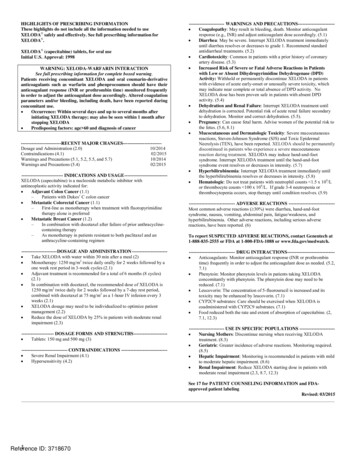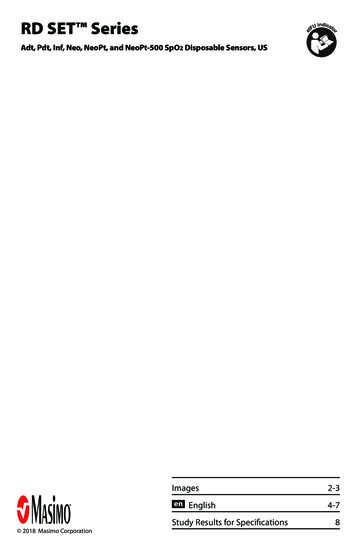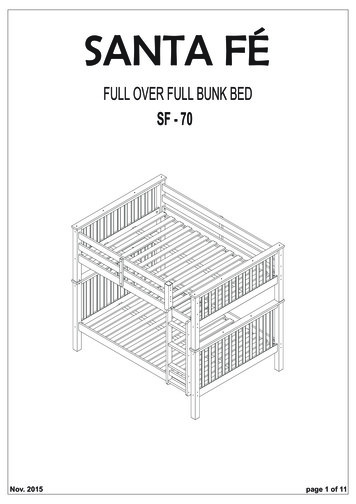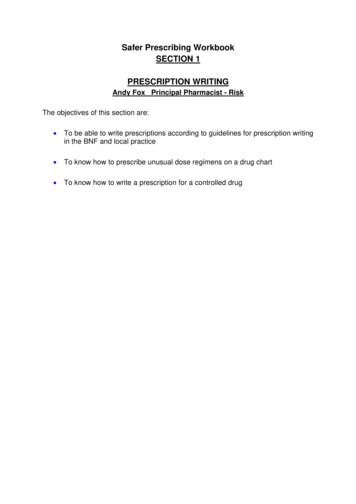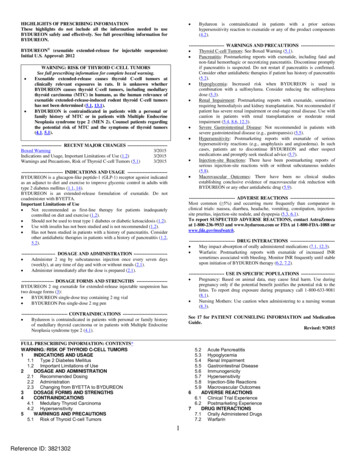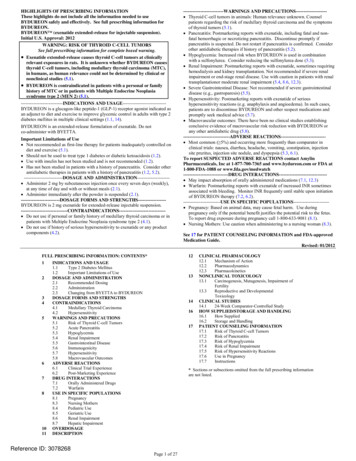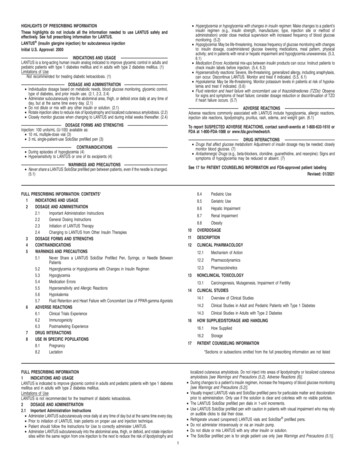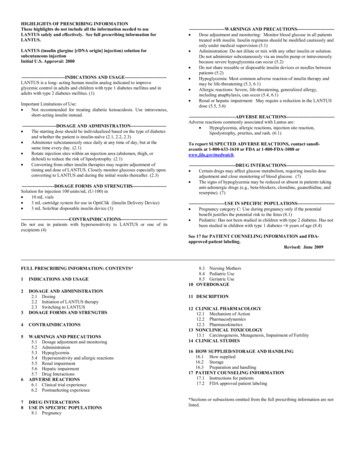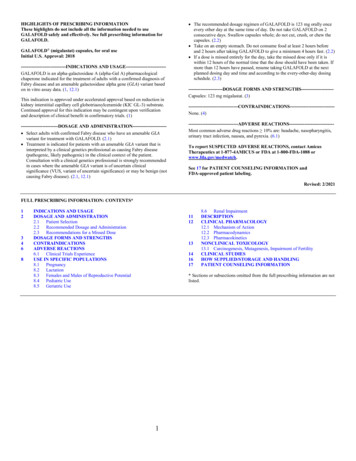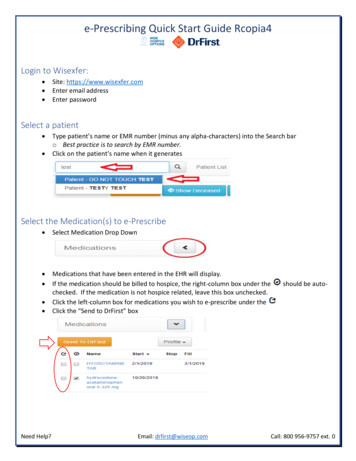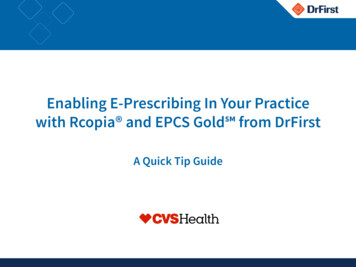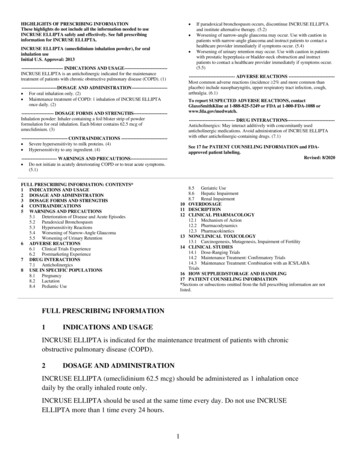
Transcription
HIGHLIGHTS OF PRESCRIBING INFORMATIONThese highlights do not include all the information needed to useINCRUSE ELLIPTA safely and effectively. See full prescribinginformation for INCRUSE ELLIPTA. INCRUSE ELLIPTA (umeclidinium inhalation powder), for oralinhalation useInitial U.S. Approval: 2013 --------------------------- INDICATIONS AND USAGE---------------------------INCRUSE ELLIPTA is an anticholinergic indicated for the maintenancetreatment of patients with chronic obstructive pulmonary disease (COPD). (1)If paradoxical bronchospasm occurs, discontinue INCRUSE ELLIPTAand institute alternative therapy. (5.2)Worsening of narrow-angle glaucoma may occur. Use with caution inpatients with narrow-angle glaucoma and instruct patients to contact ahealthcare provider immediately if symptoms occur. (5.4)Worsening of urinary retention may occur. Use with caution in patientswith prostatic hyperplasia or bladder-neck obstruction and instructpatients to contact a healthcare provider immediately if symptoms occur.(5.5)------------------------------ ADVERSE REACTIONS -----------------------------Most common adverse reactions (incidence 2% and more common thanplacebo) include nasopharyngitis, upper respiratory tract infection, cough,arthralgia. (6.1)----------------------- DOSAGE AND ADMINISTRATION ---------------------- For oral inhalation only. (2) Maintenance treatment of COPD: 1 inhalation of INCRUSE ELLIPTAonce daily. (2)To report SUSPECTED ADVERSE REACTIONS, contactGlaxoSmithKline at 1-888-825-5249 or FDA at 1-800-FDA-1088 orwww.fda.gov/medwatch.--------------------- DOSAGE FORMS AND STRENGTHS---------------------Inhalation powder: Inhaler containing a foil blister strip of powderformulation for oral inhalation. Each blister contains 62.5 mcg ofumeclidinium. (3)------------------------------ DRUG inergics: May interact additively with concomitantly usedanticholinergic medications. Avoid administration of INCRUSE ELLIPTAwith other anticholinergic-containing drugs. (7.1)------------------------------ CONTRAINDICATIONS ----------------------------- Severe hypersensitivity to milk proteins. (4) Hypersensitivity to any ingredient. (4)See 17 for PATIENT COUNSELING INFORMATION and FDAapproved patient labeling.Revised: 8/2020----------------------- WARNINGS AND PRECAUTIONS----------------------- Do not initiate in acutely deteriorating COPD or to treat acute symptoms.(5.1)FULL PRESCRIBING INFORMATION: CONTENTS*1 INDICATIONS AND USAGE2 DOSAGE AND ADMINISTRATION3 DOSAGE FORMS AND STRENGTHS4 CONTRAINDICATIONS5 WARNINGS AND PRECAUTIONS5.1 Deterioration of Disease and Acute Episodes5.2 Paradoxical Bronchospasm5.3 Hypersensitivity Reactions5.4 Worsening of Narrow-Angle Glaucoma5.5 Worsening of Urinary Retention6 ADVERSE REACTIONS6.1 Clinical Trials Experience6.2 Postmarketing Experience7 DRUG INTERACTIONS7.1 Anticholinergics8 USE IN SPECIFIC POPULATIONS8.1 Pregnancy8.2 Lactation8.4 Pediatric Use8.5 Geriatric Use8.6 Hepatic Impairment8.7 Renal Impairment10 OVERDOSAGE11 DESCRIPTION12 CLINICAL PHARMACOLOGY12.1 Mechanism of Action12.2 Pharmacodynamics12.3 Pharmacokinetics13 NONCLINICAL TOXICOLOGY13.1 Carcinogenesis, Mutagenesis, Impairment of Fertility14 CLINICAL STUDIES14.1 Dose-Ranging Trials14.2 Maintenance Treatment: Confirmatory Trials14.3 Maintenance Treatment: Combination with an ICS/LABATrials16 HOW SUPPLIED/STORAGE AND HANDLING17 PATIENT COUNSELING INFORMATION*Sections or subsections omitted from the full prescribing information are notlisted.FULL PRESCRIBING INFORMATION1INDICATIONS AND USAGEINCRUSE ELLIPTA is indicated for the maintenance treatment of patients with chronicobstructive pulmonary disease (COPD).2DOSAGE AND ADMINISTRATIONINCRUSE ELLIPTA (umeclidinium 62.5 mcg) should be administered as 1 inhalation oncedaily by the orally inhaled route only.INCRUSE ELLIPTA should be used at the same time every day. Do not use INCRUSEELLIPTA more than 1 time every 24 hours.1
No dosage adjustment is required for geriatric patients, patients with renal impairment, orpatients with moderate hepatic impairment [see Clinical Pharmacology (12.3)].3DOSAGE FORMS AND STRENGTHSInhalation powder: Disposable light grey and light green plastic inhaler containing a foil blisterstrip of powder intended for oral inhalation only. Each blister contains umeclidinium 62.5 mcg.4CONTRAINDICATIONSThe use of INCRUSE ELLIPTA is contraindicated in the following conditions: Severe hypersensitivity to milk proteins [see Warnings and Precautions (5.3)] Hypersensitivity to umeclidinium or any of the excipients [see Warnings and Precautions(5.3), Description (11)]5WARNINGS AND PRECAUTIONS5.1Deterioration of Disease and Acute EpisodesINCRUSE ELLIPTA should not be initiated in patients during rapidly deteriorating orpotentially life-threatening episodes of COPD. INCRUSE ELLIPTA has not been studied insubjects with acutely deteriorating COPD. The initiation of INCRUSE ELLIPTA in this settingis not appropriate.INCRUSE ELLIPTA should not be used for the relief of acute symptoms, i.e., as rescue therapyfor the treatment of acute episodes of bronchospasm. INCRUSE ELLIPTA has not been studiedin the relief of acute symptoms and extra doses should not be used for that purpose. Acutesymptoms should be treated with an inhaled, short-acting beta2-agonist.COPD may deteriorate acutely over a period of hours or chronically over several days or longer.If INCRUSE ELLIPTA no longer controls symptoms of bronchoconstriction; the patient’sinhaled, short-acting beta2-agonist becomes less effective; or the patient needs more short-actingbeta2-agonist than usual, these may be markers of deterioration of disease. In this setting areevaluation of the patient and the COPD treatment regimen should be undertaken at once.Increasing the daily dose of INCRUSE ELLIPTA beyond the recommended dose is notappropriate in this situation.5.2Paradoxical BronchospasmAs with other inhaled medicines, INCRUSE ELLIPTA can produce paradoxical bronchospasm,which may be life threatening. If paradoxical bronchospasm occurs following dosing withINCRUSE ELLIPTA, it should be treated immediately with an inhaled, short-actingbronchodilator; INCRUSE ELLIPTA should be discontinued immediately; and alternativetherapy should be instituted.2
5.3Hypersensitivity ReactionsHypersensitivity reactions such as anaphylaxis, angioedema, pruritus, rash, and urticaria mayoccur after administration of INCRUSE ELLIPTA. Discontinue INCRUSE ELLIPTA if suchreactions occur. There have been reports of anaphylactic reactions in patients with severe milkprotein allergy after inhalation of other powder medications containing lactose; therefore,patients with severe milk protein allergy should not use INCRUSE ELLIPTA [seeContraindications (4), Adverse Reactions (6.2)].5.4Worsening of Narrow-Angle GlaucomaINCRUSE ELLIPTA should be used with caution in patients with narrow-angle glaucoma.Prescribers and patients should be alert for signs and symptoms of acute narrow-angle glaucoma(e.g., eye pain or discomfort, blurred vision, visual halos or colored images in association withred eyes from conjunctival congestion and corneal edema). Instruct patients to consult ahealthcare provider immediately if any of these signs or symptoms develop.5.5Worsening of Urinary RetentionINCRUSE ELLIPTA, like all medicines containing an anticholinergic, should be used withcaution in patients with urinary retention. Prescribers and patients should be alert for signs andsymptoms of urinary retention (e.g., difficulty passing urine, painful urination), especially inpatients with prostatic hyperplasia or bladder-neck obstruction. Instruct patients to consult ahealthcare provider immediately if any of these signs or symptoms develop.6ADVERSE REACTIONSThe following adverse reactions are described in greater detail in other sections: Paradoxical bronchospasm [see Warnings and Precautions (5.2)] Worsening of narrow-angle glaucoma [see Warnings and Precautions (5.4)] Worsening of urinary retention [see Warnings and Precautions (5.5)]6.1Clinical Trials ExperienceBecause clinical trials are conducted under widely varying conditions, adverse reaction ratesobserved in the clinical trials of a drug cannot be directly compared with rates in the clinicaltrials of another drug and may not reflect the rates observed in practice.In the 8 clinical trials conducted to support initial approval of INCRUSE ELLIPTA, a total of1,663 subjects with COPD (mean age: 62.7 years; 89% white; 65% male across all treatments,including placebo) received at least 1 inhalation dose of umeclidinium at doses of 62.5 or125 mcg. In the 4 randomized, double-blind, placebo- or active-controlled, efficacy clinicaltrials, 1,185 subjects received umeclidinium for up to 24 weeks, of which 487 subjects receivedthe recommended dose of umeclidinium 62.5 mcg. In a 12-month, randomized, double-blind,3
placebo-controlled, long-term safety trial, 227 subjects received umeclidinium 125 mcg for up to52 weeks [see Clinical Studies (14)].The incidence of adverse reactions associated with INCRUSE ELLIPTA in Table 1 is basedupon 2 placebo-controlled efficacy trials: one 24-week trial (Trial 1, NCT #01313650) and one12-week trial (Trial 2, NCT #01387230).Table 1. Adverse Reactions with INCRUSE ELLIPTA with 1% Incidence and MoreCommon than Placebo in Subjects with Chronic Obstructive Pulmonary DiseaseINCRUSE ELLIPTAPlacebo(n 487)(n 348)Adverse Reaction%%Infections and infestationsNasopharyngitis8%7%Upper respiratory tract infection5%4%Pharyngitis1% 1%Viral upper respiratory tract infection1% 1%Respiratory, thoracic, and mediastinaldisordersCough3%2%Musculoskeletal and connective tissuedisordersArthralgia2%1%Myalgia1% 1%Gastrointestinal disordersAbdominal pain upper1% 1%Toothache1% 1%Injury, poisoning, and proceduralcomplicationsContusion1% 1%Cardiac disordersTachycardia1% 1%Other adverse reactions with INCRUSE ELLIPTA observed with an incidence 1% but morecommon than placebo included atrial fibrillation.In a long-term safety trial (Trial 3, NCT #01316887), 336 subjects (n 227 umeclidinium125 mcg, n 109 placebo) were treated for up to 52 weeks with umeclidinium 125 mcg orplacebo. The demographic and baseline characteristics of the long-term safety trial were similarto those of the efficacy trials described above. Adverse reactions that occurred with a frequency 1% in subjects receiving umeclidinium 125 mcg that exceeded that in placebo in this trial were:nasopharyngitis, upper respiratory tract infection, urinary tract infection, pharyngitis, pneumonia,4
lower respiratory tract infection, rhinitis, supraventricular tachycardia, supraventricularextrasystoles, sinus tachycardia, idioventricular rhythm, headache, dizziness, sinus headache,cough, back pain, arthralgia, pain in extremity, neck pain, myalgia, nausea, dyspepsia, diarrhea,rash, depression, and vertigo.The safety and efficacy of INCRUSE ELLIPTA in combination with an inhaledcorticosteroid/long-acting beta2-adrenergic agonist (ICS/LABA) were also evaluated in four12-week clinical trials (Trial 4, NCT #01957163; Trial 5, NCT #02119286; Trial 6,NCT #01772134; and Trial 7, NCT #01772147). A total of 1,637 subjects with COPD acrossfour 12-week, randomized, double-blind clinical trials received at least 1 dose of INCRUSEELLIPTA (62.5 mcg) or placebo administered once daily in addition to background ICS/LABA(mean age: 64 years, 88% white, 65% male across all treatments). Two trials (Trials 4 and 5)evaluated INCRUSE ELLIPTA in combination with fluticasone furoate/vilanterol (FF/VI)100 mcg/25 mcg administered once daily, and 2 trials (Trials 6 and 7) evaluated INCRUSEELLIPTA administered once daily in combination with fluticasone propionate/salmeterol(FP/SAL) 250 mcg/50 mcg administered twice daily [see Clinical Studies (14.3)]. Adversereactions that occurred with INCRUSE ELLIPTA in combination with an ICS/LABA weresimilar to those reported with INCRUSE ELLIPTA as monotherapy. In addition to theumeclidinium monotherapy adverse reactions reported above, adverse reactions occurring withINCRUSE ELLIPTA in combination with an ICS/LABA, at an incidence of 1% and exceedingICS/LABA alone, were oropharyngeal pain and dysgeusia.6.2Postmarketing ExperienceIn addition to adverse reactions reported from clinical trials, the following adverse reactions havebeen identified during postapproval use of INCRUSE ELLIPTA. Because these reactions arereported voluntarily from a population of uncertain size, it is not always possible to reliablyestimate their frequency or establish a causal relationship to drug exposure. These events havebeen chosen for inclusion due to either their seriousness, frequency of reporting, or causalconnection to INCRUSE ELLIPTA or a combination of these factors.Eye DisordersEye pain, glaucoma, vision blurred.Immune System DisordersHypersensitivity reactions, including anaphylaxis, angioedema, pruritus, and urticaria.Renal and Urinary DisordersDysuria, urinary retention.5
7DRUG INTERACTIONS7.1AnticholinergicsThere is potential for an additive interaction with concomitantly used anticholinergic medicines.Therefore, avoid coadministration of INCRUSE ELLIPTA with other anticholinergic-containingdrugs as this may lead to an increase in anticholinergic adverse effects [see Warnings andPrecautions (5.4, 5.5), Adverse Reactions (6)].8USE IN SPECIFIC POPULATIONS8.1PregnancyRisk SummaryThere are insufficient data on the use of umeclidinium in pregnant women to inform adrug-associated risk. Umeclidinium administered via inhalation or subcutaneously to pregnantrats and rabbits was not associated with adverse effect on embryofetal development at exposuresapproximately 50 and 200 times, respectively, the human exposure at the maximumrecommended human daily inhaled dose (MRHDID). (See Data.)The estimated risk of major birth defects and miscarriage for the indicated populations isunknown. In the U.S. general population, the estimated risk of major birth defects andmiscarriage in clinically recognized pregnancies is 2% to 4% and 15% to 20%, respectively.DataAnimal Data: In separate embryofetal developmental studies, pregnant rats and rabbits receivedumeclidinium during the period of organogenesis at doses up to approximately 50 and 200 timesthe MRHDID, respectively (on an AUC basis at maternal inhalation doses up to 278 mcg/kg/dayin rats and at maternal subcutaneous doses up to 180 mcg/kg/day in rabbits). No evidence ofteratogenic effects was observed in either species.In a perinatal and postnatal developmental study in rats, dams received umeclidinium during lategestation and lactation periods with no evidence of effects on offspring development at doses upto approximately 26 times the MRHDID (on an AUC basis at maternal subcutaneous doses up to60 mcg/kg/day).8.2LactationRisk SummaryThere is no information available on the presence of umeclidinium in human milk, the effects onthe breastfed child, or the effects on milk production. Umeclidinium was detected in the plasmaof offspring of lactating rats treated with umeclidinium suggesting its presence in maternal milk.(See Data.) The developmental and health benefits of breastfeeding should be considered alongwith the mother’s clinical need for INCRUSE ELLIPTA and any potential adverse effects on thebreastfed child from umeclidinium or from the underlying maternal condition.6
DataSubcutaneous administration of umeclidinium to lactating rats at greater than or equal to60 mcg/kg/day resulted in a quantifiable level of umeclidinium in 2 of 54 pups, which mayindicate transfer of umeclidinium in milk.8.4Pediatric UseINCRUSE ELLIPTA is not indicated for use in children. The safety and efficacy in pediatricpatients have not been established.8.5Geriatric UseBased on available data, no adjustment of the dosage of INCRUSE ELLIPTA in geriatricpatients is necessary, but greater sensitivity in some older individuals cannot be ruled out.Clinical trials of INCRUSE ELLIPTA included 810 subjects aged 65 years and older, and, ofthose, 183 subjects were aged 75 years and older. No overall differences in safety oreffectiveness were observed between these subjects and younger subjects, and other reportedclinical experience has not identified differences in responses between the elderly and youngersubjects.8.6Hepatic ImpairmentPatients with moderate hepatic impairment (Child-Pugh score of 7-9) showed no relevantincreases in Cmax or AUC, nor did protein binding differ between subjects with moderate hepaticimpairment and their healthy controls. Studies in subjects with severe hepatic impairment havenot been performed [see Clinical Pharmacology (12.3)].8.7Renal ImpairmentPatients with severe renal impairment (CrCl 30 mL/min) showed no relevant increases in Cmaxor AUC, nor did protein binding differ between subjects with severe renal impairment and theirhealthy controls. No dosage adjustment is required in patients with renal impairment [seeClinical Pharmacology (12.3)].10OVERDOSAGENo human overdosage data has been reported with INCRUSE ELLIPTA.High doses of umeclidinium may lead to anticholinergic signs and symptoms. However, therewere no systemic anticholinergic adverse effects following a once-daily inhaled dose of up to1,000 mcg of umeclidinium (16 times the maximum recommended daily dose) for 14 days insubjects with COPD.Treatment of overdosage consists of discontinuation of INCRUSE ELLIPTA together withinstitution of appropriate symptomatic and/or supportive therapy.7
11DESCRIPTIONINCRUSE ELLIPTA contains the active ingredient umeclidinium, an anticholinergic.Umeclidinium bromide has the chemical name azoniabicyclo[2.2.2]octane bromide and the following chemicalstructure:Umeclidinium bromide is a white powder with a molecular weight of 508.5, and the empiricalformula is C29H34NO2 Br (as a quaternary ammonium bromide compound). It is slightly solublein water.INCRUSE ELLIPTA is a light grey and light green plastic inhaler containing a foil blister strip.Each blister on the strip contains a white powder mix of micronized umeclidinium bromide(74.2 mcg equivalent to 62.5 mcg of umeclidinium), magnesium stearate (75 mcg), and lactosemonohydrate (to 12.5 mg). The lactose monohydrate contains milk proteins. After the inhaler isactivated, the powder within the blister is exposed and ready for dispersion into the airstreamcreated by the patient inhaling through the mouthpiece.Under standardized in vitro test conditions, INCRUSE ELLIPTA delivers 55 mcg ofumeclidinium per blister when tested at a flow rate of 60 L/min for 4 seconds.In adult subjects with obstructive lung disease and severely compromised lung function (COPDwith forced expiratory volume in 1 second/forced vital capacity [FEV1/FVC] 70% and FEV1 30% predicted or FEV1 50% predicted plus chronic respiratory failure), mean peak inspiratoryflow through the ELLIPTA inhaler was 67.5 L/min (range: 41.6 to 83.3 L/min).The actual amount of drug delivered to the lung will depend on patient factors, such asinspiratory flow profile.12CLINICAL PHARMACOLOGY12.1Mechanism of ActionUmeclidinium is a long-acting muscarinic antagonist, which is often referred to as ananticholinergic. It has similar affinity to the subtypes of muscarinic receptors M1 to M5. In theairways, it exhibits pharmacological effects through inhibition of M3 receptors at the smoothmuscle leading to bronchodilation. The competitive and reversible nature of antagonism wasshown with human and animal origin receptors and isolated organ preparations. In preclinical invitro as well as in vivo studies, prevention of methacholine- and acetylcholine-induced8
bronchoconstrictive effects was dose-dependent and lasted longer than 24 hours. The clinicalrelevance of these findings is unknown. The bronchodilation following inhalation ofumeclidinium is predominantly a site-specific effect.12.2PharmacodynamicsCardiac E
See 17 for PATIENT COUNSELING INFORMATION and FDA-approved patient labeling. Revised: 8/2020 FULL PRESCRIBING INFORMATION: CONTENTS* 1 INDICATIONS AND USAGE 2 DOSAGE AND ADMINISTRATION 3 DOSAGE FORMS AND STRENGTHS 4 CONTRAINDICATIONS 5 WARNINGS AND PRECAUTIONS 5.1 Deterioration o
